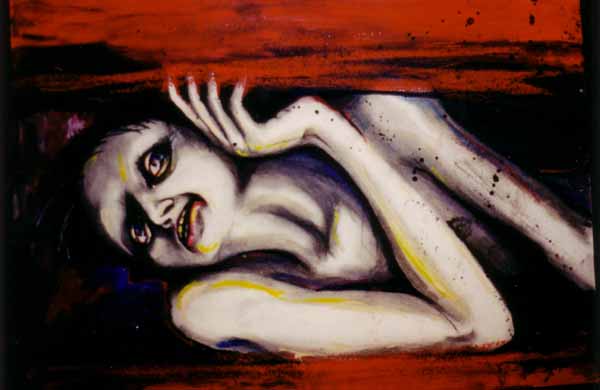Giving Corpses Acrid Enemas May 18, 2011
Author: Beach Combing | in : Modern , trackback
Beachcombing has a substantial file on individuals being accidentally buried alive and a second file full of strategies employed to avoid such unpleasantries. Being buried alive is, after all, something of a human preoccupation. Thrillers end with heroes in tiny underground boxes, cinema epics – including a notable recent effort – have been filmed in coffins: there is even a medical name for the terror of ending up in a grave with a pulse – taphophobia.
This terror, however, seems to have reached its height in the eighteenth and the nineteenth centuries. Why? A combination of medical incompetence – in many ways medicine lagged behind in this period – and that strange, particularly Victorian fascination with the unmentionable horrors lurking outside the safe confines of the drawing room.
In fact, it would be interesting to create a list of buried alive stories in nineteenth century literature: certainly it would be a long one – Le Fanu, Poe, Baron Corvo and others…: drbeachcombing AT yahoo DOT com – a select non-fiction bibliography finishes this piece
Beachcombing will return on another occasion to the various specially-designed coffins employed by anxious relatives. But for today he thought that he would muse on the medical techniques used to make sure that bodies never woke up below ground.
After all, even in the twenty-first century doctors are not entirely in agreement as to what constitutes death.
In, say, 1850, just how long could a doctor spend on deciding whether a patient was alive or dead, especially if the ‘death’ was, as it might well have been, part of an epidemic in a poor quarter of a city?
Jacques Bènigne Winslow in his classic on premature death (published in French in 1740) argued that only putrefaction – save perhaps in cases of leprosy and scurvy? – guaranteed that a subject was deceased. Memories here of those on their death bed – including George Washington – who asked that they not be buried until several days or weeks had passed.
So what does the good doctor do to sure he is burying a stiff? Beachcombing particularly likes this passage from Winslow’s opus that does demand though a certain amount of time and resources.
The individual’s nostrils are to be irritated by introducing sternutaries [sneeze makers], errhines [mucus creators], juices of onions, garlic and horse-radish… The gums are to be rubbed with garlic, and the skin stimulated by the liberal application of whips and nettles. The intestines can be irritated by the most acrid enemas, the limbs agitated through violent pulling, and the ears shocked by hideous Shrieks and excessive Noises. Vinegar and salt should be poured in the corpse’s mouth and where they cannot be had, it is customary to pour warm urine into it, which has been observed to produce happy Effects.
Oh to have been a fly on the wall when the subject woke up to thank the doctor for these happy effects! On reflection Beachcombing would have preferred dissection.
Very Select Bibliography of Buried Alive Classics – enjoy the titles:
Bondeson, Jad Buried Alive: The Terrifying History of Our Most Primal Fear (2001)
Bouchut, E. Traité des signes de la mort et des moyens de prévenir les enterrements prématurés (1849)
Braid, James Observations on trance, or human hybernation (1850)
Chaussier, Hector Histoire des infortunes qui ont ete enterres vivants (1833)
Desmaire, Paul Les morts vivants (1862)
Gannal, Felix Mort Apparente et Mort Reelle: moyens de les distinguer (1890)
Julia de Fontenelle, M. Recherches médico-légales sur l’incertitude des signes de la mort : les dangers des inhumations précipitées (1834)
Kirchmaier, Theodor and Christopher Nottnagel Elegantissimum ex physicis thema de hominibus apparenter mortuis (1670)
Lenormand, Leonce Des inhumations precipitees (1843)
Lothmar, C. J. Ueber das Lebendigbegraben (1847)
Louis, Antoine Lettres sur la certitude des signes de la mort, où l’on rassure les citoyens de la crainte d’être enterrés vivans. Avec des observations et des expériences sur les noyés (1752)
Missirini, Melchiore Pericolo di seppillire gli uomini vivi creduti morti (1837)
Pineau, Mémoire sur le danger des inhumations précipitées, et sur la nécessité d’un règlement, pour mettre les citoyens à l’abri du malheur d’être enterrés vivans. Dans lequel on rapporte des observations de personnes enterrées & ouvertes vivantes, tant dans les diocèses du Poitiers & de la Rochelle qu’ailleurs; & de plusieurs autres, qui ayant été réputées mortes pendant long-temps, sont revenues à elles, soit naturellement, soit par les secours qu’on leur a donnés; et où l’on a ajouté quelques, réflexions sur la nécessité de faire exécuter l’ordonnance, par laquelle M.M. les Evêques, défendent aux Meres de faire coucher leurs enfans avec elles, avec leurs nourrices ou autres personnes, jusqu’à ce qu’ils aient atteint l’âge de deux ans (1786)
Snart, John Thesaurus of horror; or, the charnel-house explored (1817)
Taylor, Joseph The danger of premature interment: proved from many remarkable instances of people who have recovered after being laid out for dead, and of others entombed alive, for want of being properly examined prior to interment. Also a description of the manner the ancient Egyptians, and other nations preserved and venerated their dead, and a curious account of their sepulchral ever burning lamps and mausoleums. Likewise the pernicious effects of burying in the body of churches, and confined church yards pointed out, whereby many valuable lives have been lost to the public, and their friends. Selected from historical records (1816)
Teb, William and Edward Perry Vollum Premature Burial and How it May be Prevented with special reference to trance, catalepsy, and other forms of suspended animation (1896)
Wilder, Alexander The perils of premature burial (1895)


